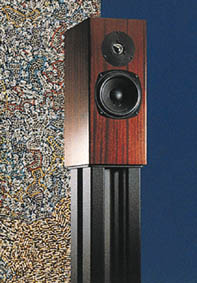 |


TechnoFILE is copyright and a registered trademark © ® of
Pandemonium Productions.
All rights reserved.
E-mail us Here!

Speakers: Big, Small, or hung from the wall?By Jim Bray Part Two: The Components We Used Part Four: Buying a Projection TV Part Eight: More on Buying Speakers Your Ears are the Best Speakers Test By Jim Bray Looking for new speakers? The most important rule of thumb to consider is "Trust Your Own Ears." You may get gobs of gobbledygook from sales people who speak in language that means something to audiophiles or engineers but, when push comes to shove, it’s your money, so you should like how a speaker sounds even if the clerk looks down his or her nose at you. Besides that, speakers should also be matched to your amplifier (or receiver, etc.), when it comes to impedance and power, and you should take a few steps to ensure you place them correctly in your room. Impedance, measured in Ohms, is the resistance of a device to electrical current (the lack of resistance creates something called a “superconductor”). If your speakers are rated at 8 ohm impedance (or 4 ohm, etc.), the amp should be rated similarly. Most mainstream systems shouldn’t pose a problem here, but remember to check! The power rating is important because if your amp pumps out too much, your speakers could end up as little smoking ruins on your living room floor. Likewise, too little power and your speakers won't be used properly and may go on strike for higher wattage. A "peak" power rating is a measure of the most power a speaker will handle before smoke starts pouring out "Continuous" power means just that: the speakers’ll hum along happily at that rating, but beware pumping much more than that into them for more than an instant or two at a time. Most amps' power ratings are given in "continuous" watts per channel (per speaker), so if you match the amp's continuous power rating to the speaker's you should be fine. This is a gross oversimplification (I haven’t mentioned “current,” for instance), but it’s all most people need to know to get up and running. Where you put your speakers is also vital to your happiness, and not just for reasons of room esthetics. For good stereo separation, the speakers should be far enough apart for a full soundstage to be heard, but not so far apart that it sounds artificial or "hollow." Experiment! If you put your speakers too close to a corner or a wall, the bass can sound too "boomy," which may be nice if you like listening to explosions – but which does little for the subtleties of a string bass. Then again, if your speakers are lacking in bass, sticking them in a corner can make 'em sound as if they have a little more "oomph" than they really have. Experiment! Manufacturers, or dealers worth their snuff, can often give you advice as to speaker placement, so don't be afraid to ask. Your speakers may even come with directions or diagrams that can help. You might even want to take a drawing of your listening room into the store with you so the salesperson can make a better recommendation of which speakers will work best in your environment. You can even try cajoling the salesperson into actually taking a look at your room – though you’re more likely to be successful here if you’re planning to spend a goodly amount at a high end store. You probably don’t need to go that far, however. While in the grand scheme of things optimum speaker placement will help ensure optimal sound, you have to live in the real world and if you’re happy with the way your speakers sound wherever you put them, you’ve undoubtedly made a good choice. Subwoofers can be placed nearly anywhere, since the energy they transmit isn’t directional, but the same rules of thumb as above apply. My subwoofer sounds best aimed into a corner, about four inches away from each wall; a sub I reviewed a few months ago sounded best next to the TV, aimed into the room. You can also “color” the sound with your amplifier's (actually your preamplifier's) tone controls, though this will get your hand slapped by high end audiophiles. Tone controls, or an equalizer, can also help compensate for flaws in your system or your room, though they’re no substitute for a well-designed room and a system that sounds good without fiddling. Remember: ignore the hype! It doesn’t matter if your speakers have the latest tweeter configurations or are constructed via black magic. Buy what you like. Jim Bray's technology columns are distributed by the TechnoFILE and Mochila Syndicates. Copyright Jim Bray.
|
|
|
| Support TechnoFile via Paypal |
| TechnoFILE's
E-letter We're pleased to offer our FREE private, subscription-based private E-mail service. It's the "no brainer" way to keep informed. Our Privacy Policy |